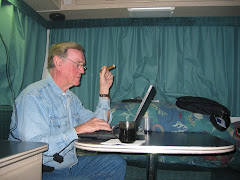
AYRES ROCK JUST BEFORE SUNRISE

AYERS ROCK AT FIRST SUNGLOW

AYERS ROCK RISEN
Excerpt from my book Our Summer in Australia & New Zealand: Amazon.com
Day Eleven. I had been looking forward to this day since first planning the trip to Australia. Climbing Ayers Rock at sunrise! It’s really not dangerous. Since records were kept beginning in 1960, there’s been only one fatality every two years, on average. Considering my life so far, those are very acceptable odds. The joke
going around is that the coroner’s report on the cause of death for people
climbing the Rock is, “death by lens cap” — another tourist dropped something halfway up the rock and forgot the warning not to chase it down. The Rock usually wins. Actually, what fatalities there have been are
from out of condition people (probably American) being overcome and suffering stroke, heart failure or heat prostration in the 115-125 daytime summer heat — otherwise known as natural selection of really dumb people who should not be out climbing The Rock. The indigenous people, the Aborigines, discourage climbing the Rock because of its meaning to them as a sacred symbol. However, for the present, it is still permitted, but perhaps not for much longer, as this is now Aboriginal property. So, today is my one chance. Another photo-op climbing something I shouldn’t. It didn’t work out! Nature interceded. The winds were too high that morning, and the park rangers didn’t want to bother with paperwork explaining what the coroner’s report meant by “got blown away.” While I spent the rest of the day reading Australian history, Elysee, who obviously is much smarter than me, in many ways, and deciding Australian history can wait until next term, spent the day in the heated swimming pool, which is why we were staying at the Lost Camel Hotel in the first place. “Good on yer Elysee.” All I have to show are sunrise pictures of The Rock, taken from about a half mile, which means, because of its size, some digital stitching a slight distortion. Sorry.
















